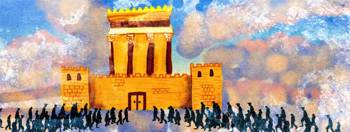Korbanot: The Biblical Temple Sacrifices
Korbanot: The Biblical Temple Sacrifices
A definitive guide to the animal sacrifices, meal and oil offerings, and wine libations
Sacrifices of animals, grain, oil, wine and other substances offered on the altar were an integral part of the service in the Mishkan (Tabernacle) in the desert, and then in the Holy Temple in Jerusalem. A service entrusted to the kohanim (priests), sacrifices are mentioned in numerous places in Scripture, and large sections of the Bible (particularly in Leviticus) are dedicated to discussing their laws.
History of Sacrifices
Sacrifices have long been part of Jewish—and human—history. The Bible records that Cain and Abel, sons of Adam and Eve, brought sacrifices to G‑d: Cain from the fruits of the ground, and Abel from the choicest of his sheep.1 Noah sacrificed animals and birds to G‑d upon leaving the Ark after the Great Flood.2 At the Binding of Isaac, Abraham brought a ram as a burnt offering in place of his son.3
During the 40 years of wandering in the desert (1313–1273 BCE), sacrifices were a mainstay of the Mishkan that accompanied the Jews during their journeys. Sacrifices continued to be brought once the Jews arrived in the Land of Israel, first in the Mishkan (which stood in Gilgal for 14 years, until 1259 BCE), then in the Tabernacle at Shiloh (for the 369 years of its existence—1259–891 BCE), and then in the First and Second Holy Temples in Jerusalem (which stood for 410 and 420 years respectively—833–423 BCE; 353 BCE–69 CE).
Types of Sacrifices
Animal sacrifices are generally divided into four categories: the burnt-offering (olah), the sin-offering (chatat), the guilt-offering (asham), and the peace-offering (shelamim).
A burnt-offering was sacrificed entirely on the altar (save for the animal’s skin). A sin- or guilt-offering would be partially burned on the altar, with the rest consumed by the priests. A peace-offering would be divided among the altar, the priests and the individual who brought the sacrifice.
Another way of categorizing the sacrifices is based on their level of sanctity. Certain sacrifices are deemed kodshei kodoshim, sacrifices of a higher level of sanctity. These sacrifices could only be consumed by male priests within the confines of the Temple courtyard. Other sacrifices are called kodoshim kalim, sacrifices of a lower level of sanctity. These sacrifices could be eaten by any Jew throughout the walled city of Jerusalem.4
Links:
Burnt-offering: Leviticus 1. Leviticus 6:1–6. Maimonides, Maaseh Hakorbanot 6.
Sin-offering: Leviticus 4. Leviticus 6:17–23. Maimonides, Maaseh Hakorbanot 7.
Guilt-offering: Leviticus 5:14–26. Leviticus 7:1–7. Maimonides, Maaseh Hakorbanot 9:1.
Peace offering: Leviticus 3. Leviticus 7:11–34. Maimonides, Maaseh Hakorbanot 9:3–24.
Who Brought Sacrifices?
All sacrifices could be brought by both men and women. Even non-Jews could bring certain sacrifices.5 However, the actual services related to the sacrifices were almost all performed by kohanim,6 who were required to pass certain criteria to qualify for the Temple service.7
Links: Leviticus 21:16–24. Maimonides, Biat Hamikdash.
What Was Sacrificed?
Only five types of animals could be brought as sacrifices: oxen, sheep, goats, turtledoves and pigeons.8 Other sacrifices known as flour-offerings (minchah) consisted of wheat or barley flour accompanied by olive oil and frankincense.9 Additionally, wine (and sometimes water) would be poured into specially designed cavities in the altar.10
Links:
Wine-offering: Maimonides, Maaseh Hakorbanot 2.
Water-offering: Maimonides, Temidin U’Musafin 10:6–10.
The oxen, sheep and goats brought as sacrifices were required to be free of any blemish.11 Additionally, depending on the category of sacrifice (see above), there were sometimes certain specifications regarding the age12 and gender13 of the animal.
Links:
Blemishes: Leviticus 22:17–25. Maimonides, Issurei Mizbeiach 1–2.
Other disqualifications for sacrifices: Maimonides, Issurei Mizbeiach 3ff.
When Were Sacrifices Brought?
Sacrifices could be brought on a number of occasions and for various reasons. Some sacrifices were voluntary: a person could be inspired to donate a sacrifice, or offer one as thanks to G‑d for saving him from danger (the thanksgiving offering). Other sacrifices were obligatory, to be brought by either the community or the individual.
Link: Showing Gratitude
The community was obligated to offer two lambs on a daily basis, as well as additional sacrifices on Shabbat, Rosh Chodesh and the holidays. An individual was obligated to bring a sacrifice as atonement for a sin, or to enable him to partake of sacred foods (if he was unable to do so beforehand due to a state of impurity).
Links: Numbers 28. Numbers 29. Maimonides, Temidin U’Musafin 6–10.
Other types of private obligatory sacrifices include the Paschal lamb, the firstborn offering, the tithe and the sacrifices brought by a nazir (nazirite).14
Links:
Paschal sacrifice: Exodus 12. Numbers 9. Maimonides, Korban Pesach.
Firstborn offering: Exodus 13. Maimonides, Bechorot 1.
Tithe: Leviticus 27:32–33. Maimonides, Bechorot 6.
Sacrifices of a nazir: Numbers 6. Maimonides, Nezirut 8.
Where Were Sacrifices Brought?
Once the Holy Temple was built, sacrifices could only be brought on the Temple Mount in Jerusalem,15 and it was forbidden to bring sacrifices anywhere else.16 This prohibition is in effect today as well, effectively making it impossible to sacrifice.17
Links: Leviticus 17:1–9. Maimonides, Maaseh Hakorbanot, ch. 18.
How Were Sacrifices Brought?
When bringing a mammal offering, the person bringing the sacrifice would rest his hands on the animal and, where applicable, confess his sins.18 The animal would then be slaughtered and its blood captured in a specially designed utensil, to be applied to the walls of the altar (via either sprinkling, smearing or pouring, depending on the type of sacrifice). Depending on the type of sacrifice, either the entire animal or certain parts of it would be sacrificed on the altar, while others parts would be eaten by the priests and/or the person who brought the sacrifice.
Read a description of the daily Temple service: Maimonides, Temidin U’Musafin 6.
Bird offerings would be slaughtered in a unique process known as melikah, entailing the use of a fingernail instead of a knife. The blood would then be applied to the wall of the altar, and, depending on the type of sacrifice, the bird would either be sacrificed on the altar or eaten by the priests.19
Links: Leviticus 1:14–17. Leviticus 5:7–10. Maimonides, Maaseh Hakorbanot 6:20–23, 7:6–8.
Most flour offerings involved a process called kemitzah: the priest would scoop three fingerfuls of flour to be sacrificed on the altar, and the rest of the flour would be eaten by the priests.20
Links: Leviticus 2. Leviticus 6:7–16. Maimonides, Maaseh Hakorbanot 12-13.
It should be noted that certain specific types of sacrifices involved unique methods of treatment that differ from the above descriptions.
Why Sacrifice?
The sacrificial service was not primarily about the physical act of slaughtering an animal; it was principally a spiritual service. On a basic level, if the sacrifice was being brought to atone for some inadvertent sin, one had to feel remorse over what had happened.21 To assist in reaching true repentance, he would bear in mind that what was being done to the animal essentially should have occurred to him.22
Another way of understanding sacrifices is that the animal one brings as an offering to G‑d is symbolic of our own inner animal, our instincts and primal desires that we must bring into alignment with G‑d’s will. We surrender that part of us to G‑d and make it submissive to Him, so that it too may seek to do His will.23
Link: All of Me
From the perspective of Kabbalah, the sacrifices were a way of elevating the matter and vitality of this world to a higher plane. In addition to elevating the various layers of the human soul, sacrifices in the Temple also elevated the actual animal being offered, thereby elevating the entire animal kingdom.24
Link: Are You Really Planning to Bring Back those Animal Sacrifices?
Sacrifices Today?
With the absence of a Temple and altar today, it is forbidden to offer sacrifices (see links below). However, our sages tell us that our prayers today are in place of the sacrifices.25 In addition to asking G‑d for our needs, prayer is a time to focus on self-improvement. It is a time when we “offer” our animal soul to G‑d, refining our animalistic tendencies and submitting them to His will.26
We pray for the time when the Third Temple will be rebuilt, where the sacrifices will be offered once more.
Links:
Can We Sacrifice a Paschal Lamb Nowadays?
Why Haven’t Jews Rebuilt the Temple Yet?
What Is Jewish Prayer?
See Maimonides’ list in Biat Hamikdash 9:15.
Maimonides, Maaseh Hakorbanot 2:1 (see Raavad ad loc.) and Temidin U’Musafin 10:6–7.
See, for example, Maimonides, Issurei Mizbeiach 3:2. Ibid., Maaseh Hakorbanot 1:14.
For a complete list of community and individual sacrifices, see Maimonides, Maaseh Hakorbanot 1:5–6.
Maimonides, Maaseh Hakorbanot 12:9, 13:13. While most authorities maintain that three fingerfuls were scooped (see Rashi to Leviticus 2:2), Maimonides is of the opinion that the kemitzah comprised four fingerfuls (see commentators to Maimonides, Maaseh Hakarbanot 13:13).
Nachmanides to Leviticus 1:9.
See Sefer Hamaamarim 5710, pp. 113–114.
See Tanya, ch. 34.
Talmud, Berachot 26b. Zohar III, 28b.
See, for example, Torah Ohr 62b. Kuntres Ha’Avodah,p. 10.













Comments
Post a Comment